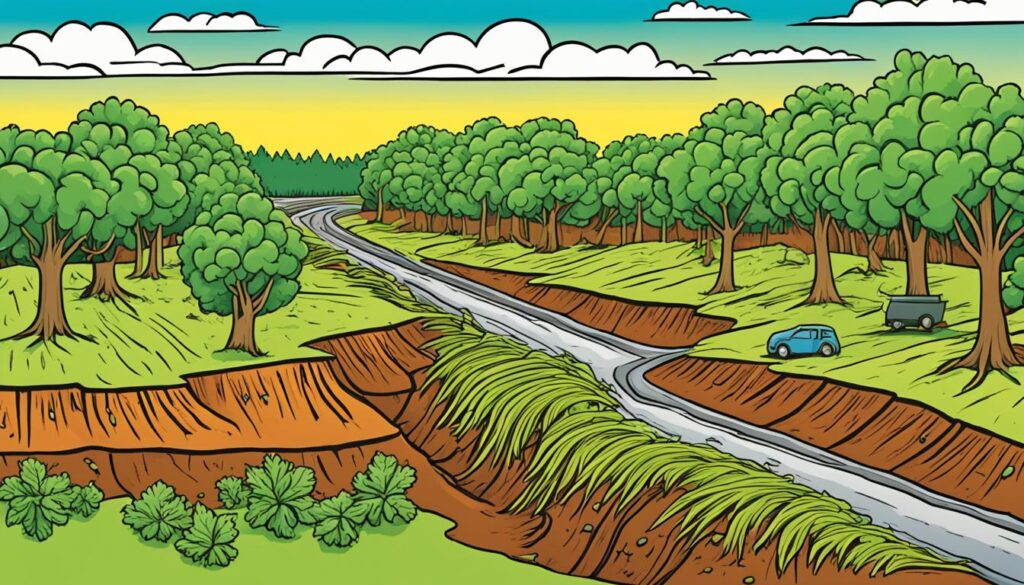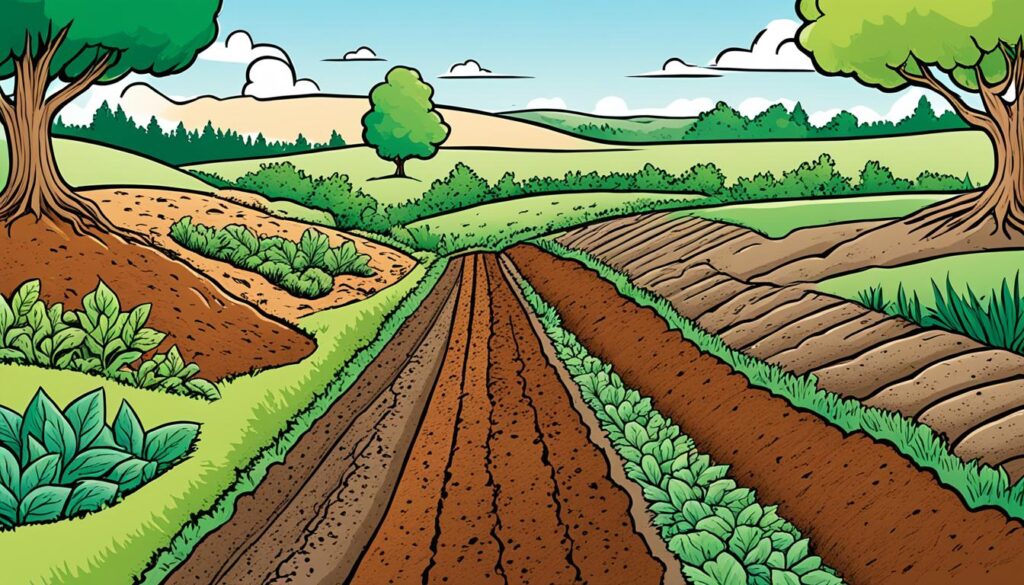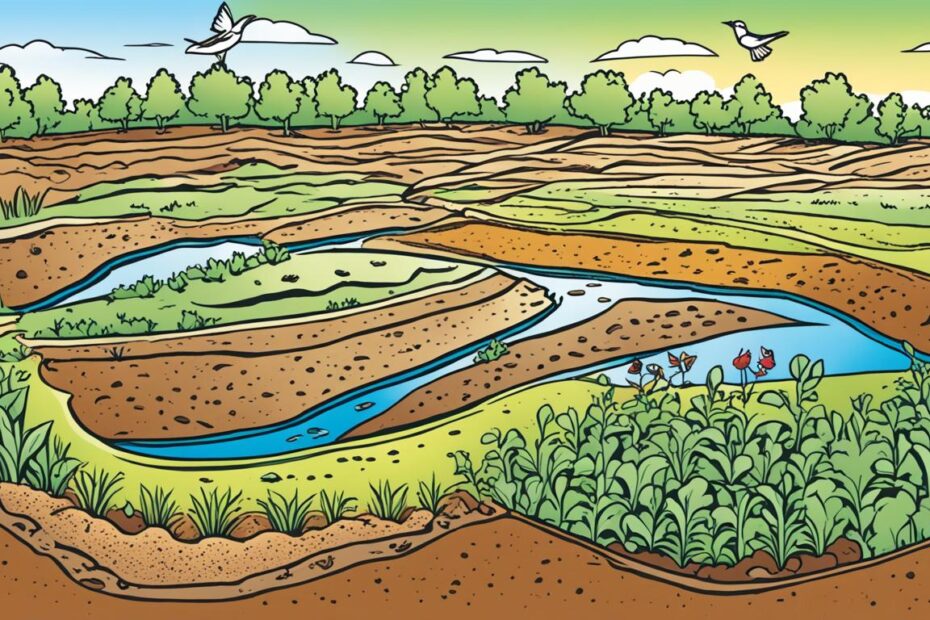Do you want to bring life back to your land? Are you tired of watching your soil erode, leaving barren patches and gullies in its wake? What if we told you there was a way to rejuvenate your land and restore its fertility?
Soil erosion is a common problem that can have devastating effects on the health and productivity of your land. But fear not! There are proven techniques and strategies that can help you replace eroded soil and revitalize your land.
In this article, we will explore effective soil restoration techniques that can bring your land back to life. From protecting the eroded areas to redirecting and capturing runoff, we will provide you with the tools and knowledge to combat soil erosion and promote a healthier, more vibrant future for your land.
Key Takeaways:
- Protect your land by replanting vegetation, using mulch or gravel, building terraces, and constructing check dams.
- Redirect and capture runoff through techniques like soil amendments, rainwater harvesting, and the use of swales or catch basins.
- Understand the root causes of soil degradation, including erosion, nutrient depletion, compaction, salinization, and chemical contamination.
- Rejuvenate degraded soils through techniques such as conservation agriculture, agroforestry, biological methods, terracing, and contouring.
- Embrace technology in soil restoration through precision farming, big data analysis, and soil monitoring sensors to ensure sustainable practices and mitigate further degradation.
Understanding the Root Cause of Soil Degradation
Soil degradation is a serious issue that can have detrimental effects on our environment and agricultural productivity. To effectively combat and prevent soil degradation, it is crucial to understand the root causes behind it.
Causes of Soil Degradation:
- Soil Erosion: Uncontrolled erosion is one of the leading causes of soil degradation. When topsoil is washed away, it strips the land of its protective vegetative cover, leaving bare spots and forming gullies.
- Nutrient Depletion: Intensive agricultural practices and excessive use of fertilizers can deplete the soil’s nutrients over time. This impacts soil fertility and hinders the growth of crops and plants.
- Compaction: Soil compaction occurs when the soil is compressed by heavy machinery or foot traffic. This reduces its ability to retain water and nutrients, making it less hospitable for plants.
- Salinization: Salinization happens when high levels of salts accumulate in the soil, rendering it unsuitable for plant growth. This can occur due to factors such as poor irrigation practices or naturally occurring saltwater intrusion.
- Chemical Contamination: Chemical contamination can arise from the use of pesticides, herbicides, or industrial activities. These chemicals can have detrimental effects on soil health, impacting its ability to support plant life.
By understanding these root causes, we can develop effective strategies and implement appropriate measures to combat and prevent soil degradation.
“Healthy soil, healthy planet, healthy you.”
| Cause | Description |
|---|---|
| Soil Erosion | Topsoil washed away, leading to loss of protective cover and gully formation. |
| Nutrient Depletion | Intensive farming and excessive fertilizer use deplete soil nutrients, affecting fertility. |
| Compaction | Soil compressed by heavy machinery or foot traffic, reducing water and nutrient retention. |
| Salinization | Accumulation of high salt levels in soil, hindering plant growth. |
| Chemical Contamination | Pesticides, herbicides, or industrial activities negatively impact soil health. |

In the next section, we will explore techniques for restoring degraded soils and revitalizing our land.
CLICK HERE TO CHECK OUR RECOMMENDED PRODUCTSRejuvenating Degraded Soils: Techniques for Soil Restoration
To rejuvenate degraded soils, various techniques can be employed. By implementing these soil restoration techniques, you can enhance soil fertility, minimize erosion, and increase the capacity of the soil to retain moisture.
Conservation Agriculture
Conservation agriculture focuses on minimal soil disturbance, crop rotation, and maintaining organic matter to reduce erosion, enhance water retention, and improve soil structure. By adopting these practices, you can protect the soil from further degradation and promote long-term sustainability in agricultural systems.
Agroforestry
Agroforestry combines trees with crops to promote carbon sequestration, prevent erosion, and enrich the soil through nutrient cycling. The presence of trees provides shade and windbreak, mitigating the impact of harsh weather conditions. Additionally, the tree roots help bind the soil, reducing the risk of erosion and enhancing its overall stability.
Biological Methods
Biological methods involve using beneficial microbes, fungi, and earthworms to improve soil health, nutrient availability, and plant growth. These organisms help break down organic matter, increase the decomposition rate, and enhance the soil’s ability to absorb and retain nutrients. Incorporating biological methods can significantly enhance the overall health and productivity of degraded soils.
Terracing and Contouring
Terracing and contouring are effective techniques for controlling erosion on steep slopes. By creating terraces, it slows down water runoff, preventing it from washing away fertile topsoil. Contouring involves creating ridges and furrows to redirect water flow and promote sediment buildup. These techniques help to retain water, reduce soil erosion, and create a more favorable environment for plant growth.

By employing these diverse soil restoration techniques such as conservation agriculture, agroforestry, biological methods, terracing, and contouring, you can rejuvenate degraded soils and pave the way for sustainable and resilient agricultural systems. These methods not only enhance the fertility and stability of the soil but also contribute to environmental conservation and long-term food security.
CLICK HERE TO CHECK OUR RECOMMENDED PRODUCTSThe Role of Technology in Soil Restoration
Technology is revolutionizing the field of soil restoration, offering innovative solutions to combat degradation and restore the health of our lands. Precision farming, big data analysis, and soil monitoring sensors are key technological advancements that play a crucial role in this process.
Precision farming, also known as smart farming, harnesses the power of advanced tools such as GPS, remote sensing, and drones to optimize agricultural practices. By monitoring soil conditions in real-time, farmers can make informed decisions about irrigation, fertilization, and crop management. This targeted approach ensures that resources are applied precisely where they are needed, minimizing waste and maximizing efficiency. With precision farming, we can achieve optimal crop yields while minimizing the environmental impact.
Big data analysis is another invaluable technology in soil restoration. By harnessing the power of data analytics, experts can develop predictive models and gain valuable insights into soil health and degradation patterns. This allows for proactive interventions and the implementation of sustainable farming practices. By making informed decisions based on comprehensive data analysis, we can prevent soil degradation and ensure the long-term viability of our agricultural systems.
| Technology | Description |
|---|---|
| Precision Farming | Utilizes advanced tools like GPS, remote sensing, and drones to monitor soil conditions and optimize agricultural practices. |
| Big Data Analysis | Applies data analytics to develop predictive models, gain insights into soil health, and make informed decisions for sustainable farming. |
| Soil Monitoring Sensors | Provide real-time data on crucial soil parameters such as moisture content, temperature, and nutrient levels. |
Soil monitoring sensors are instrumental in gathering real-time data on crucial soil parameters. These sensors measure factors such as moisture content, temperature, and nutrient levels, providing farmers with accurate and up-to-date information. With this data, farmers can make informed adjustments to irrigation schedules and fertilization plans, optimizing resource allocation and minimizing waste. Soil monitoring sensors enable us to monitor the health of the soil with unparalleled precision, ensuring its long-term viability.
By integrating technology into soil restoration practices, we can harness its power to monitor, manage, and revitalize our lands more effectively. Precision farming, big data analysis, and soil monitoring sensors empower us to make informed decisions, optimize resource allocation, and prevent further degradation. As we continue to embrace technological advancements, we pave the way for sustainable farming practices, ensuring a greener and more prosperous future for generations to come.
Conclusion
Restoring degraded soils is not only crucial for improving crop yields but also has far-reaching benefits for our planet. By undertaking soil restoration practices, you are contributing to the enhancement of food security and ensuring a steady food supply for current and future generations.
One of the significant advantages of soil restoration is its role in mitigating climate change. By acting as a natural carbon sink, restored soils sequester CO2 from the atmosphere, helping to reduce greenhouse gas emissions and combat the effects of global warming. This makes soil restoration a vital strategy in our collective efforts to create a more sustainable and resilient planet.
Moreover, restoring degraded soils has a positive impact on biodiversity conservation. By reviving ecosystems through soil restoration, we create a favorable environment for diverse flora and fauna to thrive. This biodiversity not only supports robust and resilient ecosystems but also contributes to the overall health and sustainability of the planet.
By embracing the power of soil restoration, you are playing a crucial role in building a greener and more prosperous future. Your commitment to sustainable agriculture and soil restoration paves the way for a healthier planet and brings us closer to achieving long-term food security, climate change mitigation, and biodiversity conservation. Together, let us restore our degraded soils and create a brighter future for all.
FAQ
What is soil erosion?
Soil erosion is the process by which topsoil is washed away, leading to the loss of protective vegetative cover and the formation of gullies.
How does nutrient depletion affect soil?
Nutrient depletion occurs when intensive agricultural practices and excessive use of fertilizers lead to a decrease in soil fertility.
What is soil compaction?
Soil compaction is the result of soil being compacted by heavy machinery or foot traffic, reducing its ability to retain water and nutrients.
What causes salinization?
Salinization occurs when high levels of salts accumulate in the soil, hindering plant growth.
What is chemical contamination?
Chemical contamination happens when pesticides or industrial activities introduce harmful substances into the soil, negatively impacting soil health.
What is conservation agriculture?
Conservation agriculture is an approach that focuses on minimal soil disturbance, crop rotation, and maintaining organic matter to reduce erosion and improve soil structure.
What is agroforestry?
Agroforestry combines trees with crops to promote carbon sequestration, prevent erosion, and enrich the soil through nutrient cycling.
How do biological methods improve soil health?
Biological methods involve using beneficial microbes, fungi, and earthworms to improve soil health, nutrient availability, and plant growth.
How do terracing and contouring control erosion?
Terracing and contouring are techniques that slow down water runoff and allow sediment build-up, effectively reducing erosion on steep slopes.
How does precision farming help with soil restoration?
Precision farming utilizes advanced tools like GPS, remote sensing, and drones to monitor soil conditions, optimize irrigation, and apply fertilizers precisely where needed, minimizing waste and improving efficiency.
What is the role of big data analysis in soil restoration?
Big data analysis allows experts to develop predictive models and make informed decisions to prevent soil degradation and ensure sustainable farming practices.
How do soil monitoring sensors aid in soil restoration?
Soil monitoring sensors provide real-time data on crucial soil parameters such as moisture content, temperature, and nutrient levels, enabling farmers to make informed adjustments to irrigation and fertilization plans.
What are the benefits of restoring degraded soils?
Restoring degraded soils enhances food security, acts as a natural carbon sink to mitigate climate change, and fosters biodiversity conservation by creating a conducive environment for diverse flora and fauna.
